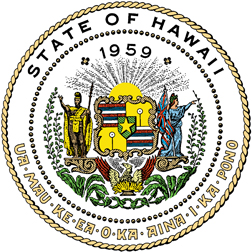Release: Abercrombie Administration Requests Federal Recognition of Hawaii’s Unique Biosecurity Needs
Posted on Apr 25, 2014 in News, Press release
NEIL ABERCROMBIE
GOVERNOR
WILLIAM J. AILA, JR.
CHAIRPERSON, BOARD OF LAND AND NATURAL RESOURCES
SCOTT ENRIGHT
CHAIRPERSON, BOARD OF AGRICULTURE
FOR IMMEDIATE RELEASE
April 25, 2014
Abercrombie Administration Requests Federal Recognition of Hawaii’s Unique Biosecurity Needs
“Hawaii Biosecurity Resolutions Package” Encourages Federal-State Coordination
HONOLULU —The Abercrombie Administration has released a 2014 Hawaii Biosecurity Resolutions Package to federal agency heads at the U.S. Departments of Agriculture, Defense, Interior and Transportation as well as the Council on Environmental Quality at the White House that consists of four resolutions adopted by the cabinet-level Hawaii Invasive Species Council (HISC) in recent years regarding federal invasive species policies.
Invasive species issues are a top priority for Gov. Abercrombie and his administration. On the topic of state and federal coordination, the Governor stated, “The federal government is an important partner in protecting our islands from the impacts of invasive species, from assisting our Hawaii Department of Agriculture in controlling Coconut Rhinoceros Beetle, to keeping the brown tree snake out of Hawaii.
“This administration is committed to working with federal partners to maximize resources available in addressing invasive species issues at both the state and federal level. Our Hawaii Biosecurity Resolutions Package identifies some additional areas of great importance to Hawai‘i where we can and should collaborate with the federal government, and we look forward to strengthening our federal-state partnerships in these areas.”
The Governor directed his cabinet members to work across departments through the HISC, an interagency board created by the state Legislature in 2003. Among the HISC’s responsibilities is the coordination of the state’s position with regard to federal invasive species issues. The letter from Gov. Abercrombie, dispatched to federal agencies in March, references recent HISC resolutions that highlight key federal invasive species issues impacting Hawaii:
- Requesting federal recognition of Hawaii’s unique biosecurity needs —The U.S. Plant Protection Act of 2000 prevents the state from regulating in foreign and interstate commerce pests that may threaten Hawaii but are not federally listed as threats to U.S. agriculture. However, Hawaii’s environment is susceptible to a wide variety of pests that might not be considered threats to the rest of the country. The State of Hawaii will be requesting U.S. Department of Agriculture’s assistance to better regulate pest species of state concern, and the ability to share information between federal and state inspectors.
- Reauthorization of the Brown Tree Snake Control and Eradication Act —In 2004 this act authorized several years of federal funds to support detection, control and research pertaining to the invasive brown tree snake in multiple locations around the Pacific. The brown tree snake is not found in Hawaii but remains a high-risk pest for potential introduction from infested areas, including Guam. The funding authorization provided under this act expired in 2010. Federal funding is required to continue the intensive pre-departure interdiction efforts on Guam that help minimize the risk of accidental transport of snakes to Hawaii.
- Amendments to the federal list of injurious species under the Lacey Act —The federal Lacey Act prohibits the transportation, acquisition, sale or purchase of species listed as injurious wildlife. The State of Hawaii supports the recommendation of the U.S. Fish and Wildlife Service to add a number of constrictor snake species to this list, including the reticulated python, boa constrictor, DeSchauensee’s anaconda, green anaconda, and Beni anaconda. There are no native terrestrial snake species in Hawaii, but a number of snake species have been recovered in Hawaii. In particular, 42 boa constrictors and two reticulated pythons were recovered in Hawaii between June 1990 and December 2011. Continuing the listing process for injurious wildlife and adding these five snake species would enhance biosecurity for Hawaii as well as other states.
- Supporting the Micronesian Biosecurity Plan —The U.S. Department of Defense is developing the Micronesian Biosecurity Plan (MBP) in preparation for potential military relocations in the Pacific region, recognizing the potential for the accidental transport of invasive species. The MBP is both a risk assessment of potential invasive species pathways in the Pacific and a set of recommendations for enhancing Pacific biosecurity. The State of Hawaii recognizes and appreciates the U.S. Department of Defense funding for this risk assessment and is committed to working with Pacific partners to implement effective biosecurity programs.
Invasive species have been a topic of discussion during the 2014 State Legislative session. In this year’s State of the State Address, the Governor expressed his strong support of the joint majority package request for funding for fiscal year 2015 to be disbursed by the HISC on projects that strategically progress invasive species prevention, control, outreach and research. These funds may help bolster early detection programs and the state’s response to the spread of little fire ant across Hawaii Island and to other islands in the state. While federal partners have been a crucial part of the response to the Coconut Rhinoceros Beetle infestation detected in December 2013, the little fire ant is not considered a federally actionable pest because it is already found in parts of the U.S. Mainland.
To learn more about the Hawaii Invasive Species Council, visit: https://hisc.hawaii.gov
[To view the full Biosecurity Resolutions Package, visit our HISC Resolutions Page]The Hawaii Invasive Species Council (HISC) is a cabinet-level interagency collaboration mandated by Chapter 194, Hawaii Revised Statutes. It is co-chaired by the Department of Land and Natural Resources and the Department of Agriculture with additional voting members from the Departments of Health, Transportation, and Business, Economic Development and Tourism, as well as the University of Hawaii. The HISC approves an annual budget to support invasive species prevention, control, and public outreach projects across the state.
# # #
Media Contacts:
Justin Fujioka
Press Secretary
(808) 586-0012
Deborah Ward
Public Information Officer
Department of Land and Natural Resources
(808) 587-0320
Janelle Saneishi
Public Information Officer
Department of Agriculture
(808) 973-9560